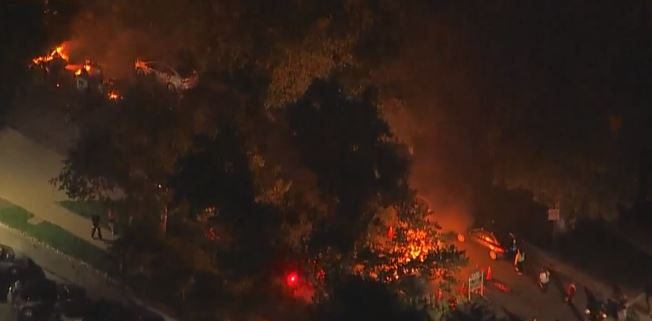AURORA, Colo. (KDVR) — Newly released police body camera video obtained by the Problem Solvers shows some of the 736 times Aurora police officers reported using force over two days of the 2020 George Floyd protests.
The video also shows protesters lobbing rocks and bottles and deploying fireworks and other items at law enforcement during the days-long protests and riots in Downtown Denver.
The Aurora Police Department’s Force Investigations Unit — established nearly six months after the protests to comply with a new police accountability law — found officers’ uses of force were “policy compliant.”
In May — about a year after the protests — an Aurora Force Review Board reviewed the unit’s findings and determined “all uses of force complied with policy and were within state law,” according to Matthew Longshore, a public information officer for the Aurora Police Department.
Through an open records request, the Problem Solvers obtained nearly 800 pages of police use-of-force reports and other documents related to the investigation. FOX31 also obtained hours of video from the event in which Aurora provided support to the Denver Police Department.
The records include officers’ first-hand accounts of their experiences during the protests and their own accounting of the types of weapons they used.
Which weapons did police use against protesters?
An analysis by the Problem Solvers found 42 individual officers said they either used force or munitions approximately 736 times between during protests on May 30-31, 2020.
That includes the launch of:
- bean bags;
- pepper spray;
- white smoke;
- CS gas (also known as tear gas);
- OC spray (also known as pepper spray);
- sting ball grenades;
- 40mm foam batons;
- pushing someone with a police baton;
- deploying noise flash diversion devices;
- and using a Taser.

Officers said they used the 40mm foam baton most often.
Over the course of two days, 17 different officers reported deploying at least 412 rounds of the less-lethal weapon, which is also referred to by some departments as a “sponge grenade.” The projectile has a hard rubber tip and is deployed through a launcher when an officer pulls the trigger.
The less lethal weapon was the subject of a recent FOX31 investigative series after at least seven people who were at or near the protests reported traumatic eye injuries.
Among those people, two men lost sight in one eye.
Many suspected the 40mm police projectiles might be to blame for their injuries, and some have filed lawsuits related to their allegations, although no department has taken responsibility for the injuries.
Which officers deployed weapons the most?
The second device Aurora officers used most during the George Floyd protests was the beanbag shot gun. Officers said they deployed a total of at least 206 bean bags.
Officers used a combined total of approximately 101 rounds of OC gas, CS gas, pepper-spray foggers, sting balls and smoke to disperse crowds.
The Problem Solvers analysis found Matthew Brukbacher, who at the time was a sergeant leading the Emergency Response Team, reported using the most force during the course of the two days. According to his own recollection of the event in documents he filed with Aurora police, he said he fired at least 106 munitions.
Brukbacher reported deploying at least 61 foam batons, at least 44 rounds of CS gas or OC gas and one sting ball.
Through a public information officer, Brukbacher, who is now a lieutenant, declined to be interviewed by the Problem Solvers for this story.
Protesters showed ‘vile hatred and irrational anger’
According to his written reports, Brukbacher said he witnessed “rocks, bottles and fireworks directed at officers” during the protests. He also reported that he was “struck by at least three large rocks causing minor injury to my upper arms and groin.”
Brukbacher also said the event was “highly dangerous and dynamic.”
Other officers reported similar, dangerous circumstances.
According to Dale Leonard, who worked as a sergeant during the protests, “rioters…were repeatedly and continuously throwing rocks, glass bottles, plastic bottles with unknown pink liquids, paint balls and pieces of concrete along with large explosive fireworks directly at us and hitting myself and other officers standing nearby me.”

Leonard’s written narrative of the event said his crew endured an “unprovoked attack” and that he ordered other officers “to target the rioters who were visibly assaulting us with less-lethal 40mm projectiles and sock rounds.”
“The vile hatred and irrational anger displayed by these suspects towards us was alarming and coupled with their physical assault on officers I determined that we must defend ourselves and we did so,” Leonard wrote.
Another officer, Darren Chamberland, reported some rioters were bringing dumpsters out of the alley “as barriers/possibly to light on fire.”
Tim Glenn, a detective, said he was struck on the head by “an unknown hard object, presumably a rock.” In his written supplemental report, he described observing “many large rocks, bottles, fireworks and chemical munitions being thrown at the officers. I observed one party launching rocks towards officers with a lacrosse stick,” Glenn said.
Aurora Police Chief Vanessa Wilson initially agreed to an on-camera interview with the Problem Solvers about the 2020 protests, but the police department canceled the interview.
